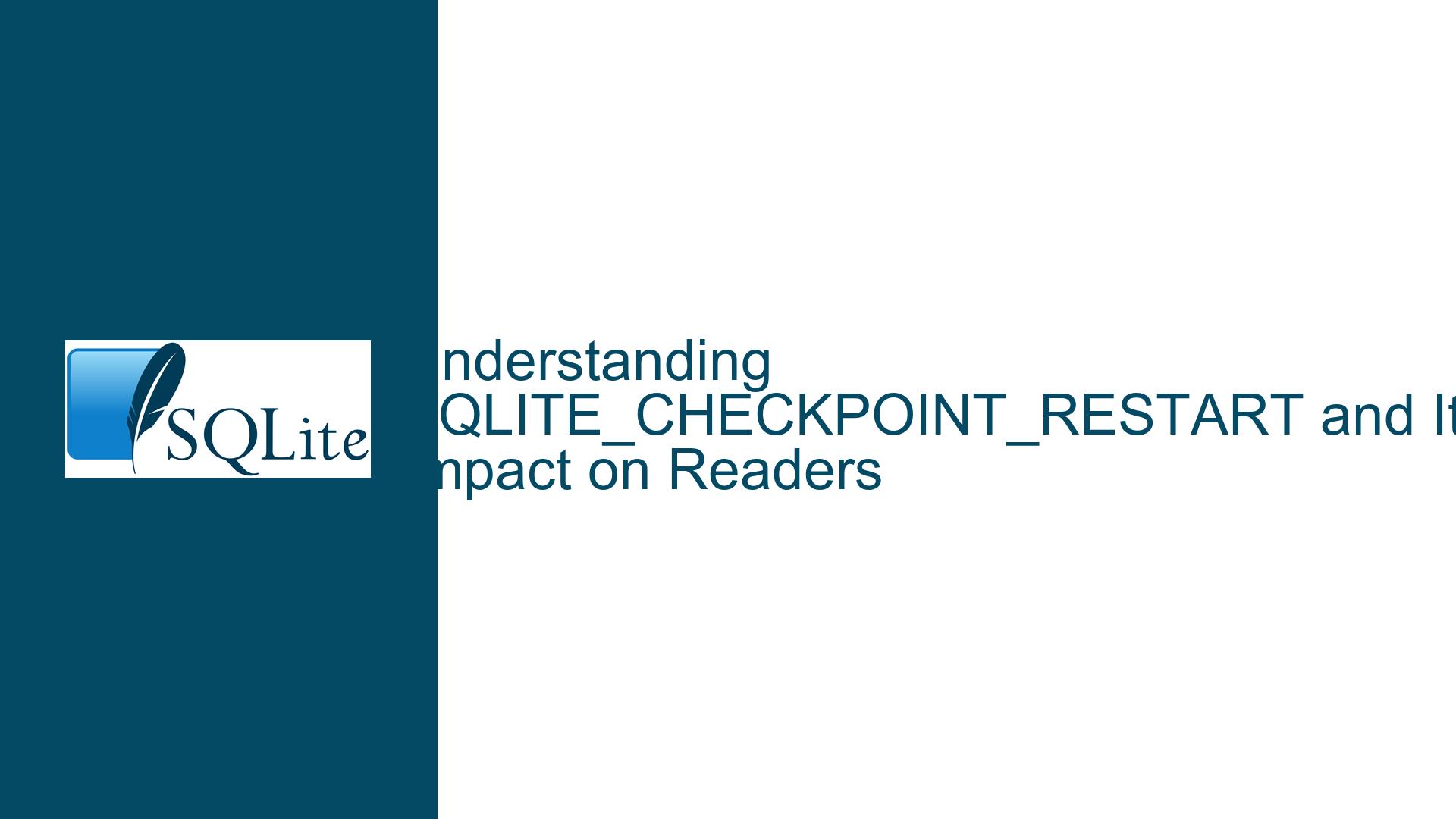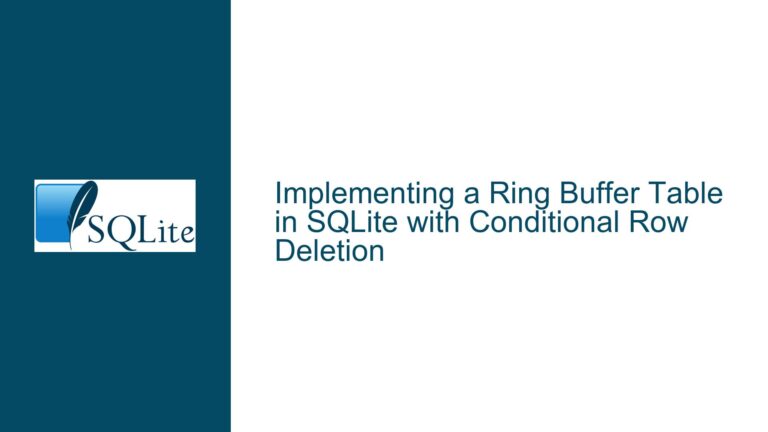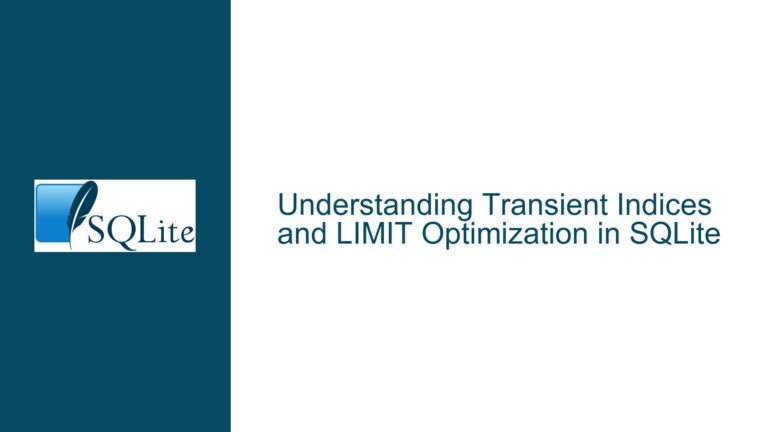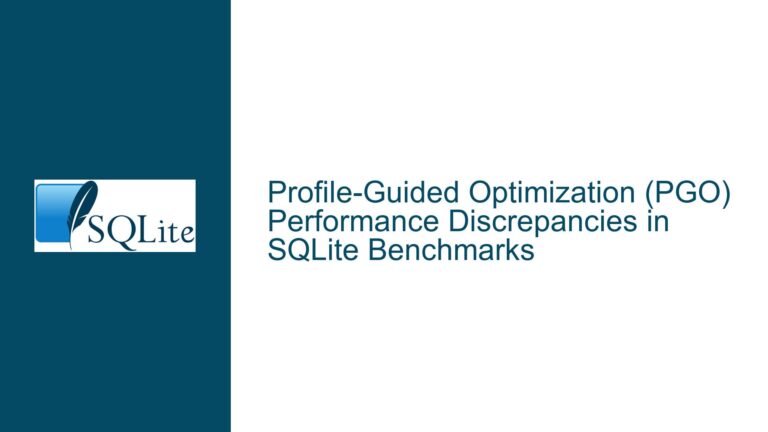SQLITE_CHECKPOINT_RESTART and Its Impact on Readers
Issue Overview: Contradictory Documentation on SQLITE_CHECKPOINT_RESTART Behavior
The core issue revolves around the behavior of the SQLITE_CHECKPOINT_RESTART command in SQLite, specifically whether it blocks readers during its execution. The confusion arises from seemingly contradictory statements in the official SQLite documentation. On one hand, the WAL (Write-Ahead Logging) documentation suggests that SQLITE_CHECKPOINT_RESTART and SQLITE_CHECKPOINT_TRUNCATE may block readers while the checkpoint is running. On the other hand, the C API documentation for sqlite3_wal_checkpoint_v2 states that SQLITE_CHECKPOINT_RESTART does not impede readers, similar to SQLITE_CHECKPOINT_FULL.
This discrepancy has led to uncertainty about the true behavior of SQLITE_CHECKPOINT_RESTART, particularly in scenarios where database performance and concurrency are critical. Understanding the nuances of this command is essential for database developers who rely on SQLite’s WAL mode for high-concurrency applications. The WAL mode is designed to allow multiple readers and a single writer to operate concurrently without blocking each other, making the behavior of checkpoints a critical factor in maintaining database performance.
To fully grasp the issue, it is important to understand the role of checkpoints in SQLite’s WAL mode. In WAL mode, changes to the database are first written to a separate WAL file, which is later integrated into the main database file during a checkpoint operation. Checkpoints are necessary to prevent the WAL file from growing indefinitely and to ensure that changes are eventually written to the main database file. The SQLITE_CHECKPOINT_RESTART command is one of several checkpoint modes available in SQLite, each with different implications for database performance and concurrency.
The confusion in the documentation highlights a broader challenge in understanding how different checkpoint modes interact with readers and writers in SQLite. This issue is particularly relevant for developers who need to optimize their database operations for high-concurrency environments, where blocking readers could lead to significant performance degradation. Therefore, clarifying the behavior of SQLITE_CHECKPOINT_RESTART is crucial for ensuring that database operations are both efficient and reliable.
Possible Causes: Misinterpretation of Checkpoint Modes and Their Concurrency Implications
The apparent contradiction in the documentation may stem from a misunderstanding of the different checkpoint modes and their respective concurrency implications. SQLite provides several checkpoint modes, including SQLITE_CHECKPOINT_PASSIVE, SQLITE_CHECKPOINT_FULL, SQLITE_CHECKPOINT_RESTART, and SQLITE_CHECKPOINT_TRUNCATE. Each mode has a distinct impact on database operations, particularly in terms of how they interact with readers and writers.
The SQLITE_CHECKPOINT_PASSIVE mode is the least intrusive, as it allows both readers and writers to continue operating while the checkpoint is in progress. However, it does not guarantee that the WAL file will be truncated, which can lead to the WAL file growing indefinitely if checkpoints are not performed regularly. In contrast, SQLITE_CHECKPOINT_FULL ensures that the WAL file is truncated, but it may block new writers while the checkpoint is running. Importantly, SQLITE_CHECKPOINT_FULL does not block readers, allowing them to continue accessing the database during the checkpoint.
The SQLITE_CHECKPOINT_RESTART mode is designed to restart the WAL file from the beginning, effectively truncating it and ensuring that it does not grow excessively. According to the C API documentation, this mode behaves similarly to SQLITE_CHECKPOINT_FULL in that it blocks new writers but does not impede readers. However, the WAL documentation suggests that SQLITE_CHECKPOINT_RESTART may block readers, leading to the confusion.
One possible explanation for this discrepancy is that the behavior of SQLITE_CHECKPOINT_RESTART may depend on the specific circumstances under which it is executed. For example, if the WAL file is particularly large or if there are many pending changes that need to be integrated into the main database file, the checkpoint operation may take longer and could potentially block readers. Alternatively, the documentation may have been updated at different times, leading to inconsistencies in how the behavior of SQLITE_CHECKPOINT_RESTART is described.
Another potential cause of the confusion is the distinction between blocking new writers and blocking existing readers. While SQLITE_CHECKPOINT_RESTART may block new writers from starting while the checkpoint is in progress, it may not necessarily block existing readers from continuing their operations. This subtle distinction could lead to different interpretations of the documentation, particularly if the reader is not familiar with the nuances of SQLite’s concurrency model.
Finally, it is possible that the behavior of SQLITE_CHECKPOINT_RESTART has evolved over time, with changes in the SQLite codebase leading to differences in how the command is documented. SQLite is an actively maintained project, and updates to the codebase may result in changes to the behavior of certain commands, which may not always be immediately reflected in the documentation. This could explain why the WAL documentation and the C API documentation provide different descriptions of the behavior of SQLITE_CHECKPOINT_RESTART.
Troubleshooting Steps, Solutions & Fixes: Clarifying the Behavior of SQLITE_CHECKPOINT_RESTART
To resolve the confusion surrounding the behavior of SQLITE_CHECKPOINT_RESTART, it is necessary to take a systematic approach to understanding how this command interacts with readers and writers in SQLite. The following steps outline a comprehensive process for clarifying the behavior of SQLITE_CHECKPOINT_RESTART and ensuring that database operations are optimized for concurrency and performance.
Step 1: Review the SQLite Source Code and Documentation
The first step in resolving the issue is to thoroughly review the SQLite source code and documentation to gain a deeper understanding of how SQLITE_CHECKPOINT_RESTART is implemented. The SQLite source code is openly available, and examining the relevant sections can provide insights into the behavior of the command. Specifically, it is important to look at the implementation of the sqlite3_wal_checkpoint_v2 function and how it handles different checkpoint modes.
In addition to reviewing the source code, it is essential to carefully read the official SQLite documentation, paying close attention to any updates or changes that may have been made over time. The documentation may provide additional context or clarification that is not immediately apparent from the source code alone. It is also helpful to look for any discussions or bug reports related to SQLITE_CHECKPOINT_RESTART in the SQLite mailing list or forums, as these may provide further insights into the behavior of the command.
Step 2: Conduct Empirical Testing
Once the source code and documentation have been reviewed, the next step is to conduct empirical testing to observe the behavior of SQLITE_CHECKPOINT_RESTART in a controlled environment. This involves setting up a test database in WAL mode and performing checkpoints using different modes, including SQLITE_CHECKPOINT_RESTART. During these tests, it is important to monitor the behavior of both readers and writers to determine whether the checkpoint blocks readers or only blocks new writers.
To conduct these tests, it is helpful to use a tool or script that can simulate concurrent readers and writers accessing the database. This will allow for a more accurate assessment of the impact of SQLITE_CHECKPOINT_RESTART on database concurrency. The results of these tests should be carefully documented and compared against the behavior described in the SQLite documentation to identify any discrepancies.
Step 3: Analyze the Results and Draw Conclusions
After conducting the empirical tests, the next step is to analyze the results and draw conclusions about the behavior of SQLITE_CHECKPOINT_RESTART. If the tests confirm that SQLITE_CHECKPOINT_RESTART does not block readers, then the C API documentation is likely accurate, and the WAL documentation may contain an error or outdated information. Conversely, if the tests show that SQLITE_CHECKPOINT_RESTART does block readers, then the WAL documentation is likely correct, and the C API documentation may need to be updated.
In either case, it is important to document the findings and share them with the SQLite community, particularly if there are discrepancies between the observed behavior and the documentation. This can help ensure that the documentation is accurate and up-to-date, and it can also provide valuable insights for other developers who may encounter similar issues.
Step 4: Implement Best Practices for Checkpointing
Based on the findings from the empirical tests, the final step is to implement best practices for checkpointing in SQLite. If SQLITE_CHECKPOINT_RESTART is found to block readers, then it may be necessary to use alternative checkpoint modes, such as SQLITE_CHECKPOINT_PASSIVE or SQLITE_CHECKPOINT_FULL, depending on the specific requirements of the application. It is also important to consider the frequency of checkpoints and the size of the WAL file, as these factors can impact database performance and concurrency.
In general, it is recommended to use SQLITE_CHECKPOINT_PASSIVE for most applications, as it allows both readers and writers to continue operating while the checkpoint is in progress. However, if the WAL file is growing excessively, then SQLITE_CHECKPOINT_FULL or SQLITE_CHECKPOINT_RESTART may be necessary to truncate the WAL file and prevent it from consuming too much disk space. In these cases, it is important to carefully monitor the impact of the checkpoint on database performance and adjust the checkpoint frequency as needed.
Step 5: Monitor and Optimize Database Performance
Finally, it is important to continuously monitor and optimize database performance to ensure that checkpoints are not causing unnecessary delays or blocking. This involves regularly reviewing database logs and performance metrics to identify any potential issues and making adjustments as needed. For example, if checkpoints are taking too long or causing significant delays, it may be necessary to optimize the database schema or queries to reduce the amount of data that needs to be written to the WAL file.
In addition to monitoring performance, it is also helpful to implement automated tools or scripts that can perform checkpoints at regular intervals or when certain conditions are met. This can help ensure that checkpoints are performed consistently and efficiently, without requiring manual intervention. By following these best practices, developers can ensure that their SQLite databases are both performant and reliable, even in high-concurrency environments.
In conclusion, the behavior of SQLITE_CHECKPOINT_RESTART in SQLite is a complex issue that requires a thorough understanding of the SQLite source code, documentation, and concurrency model. By following the steps outlined above, developers can clarify the behavior of SQLITE_CHECKPOINT_RESTART and implement best practices for checkpointing that optimize database performance and concurrency. This will help ensure that SQLite databases are both efficient and reliable, even in demanding applications.






